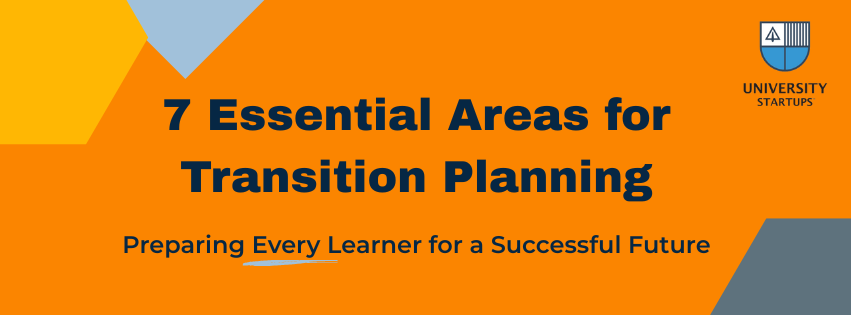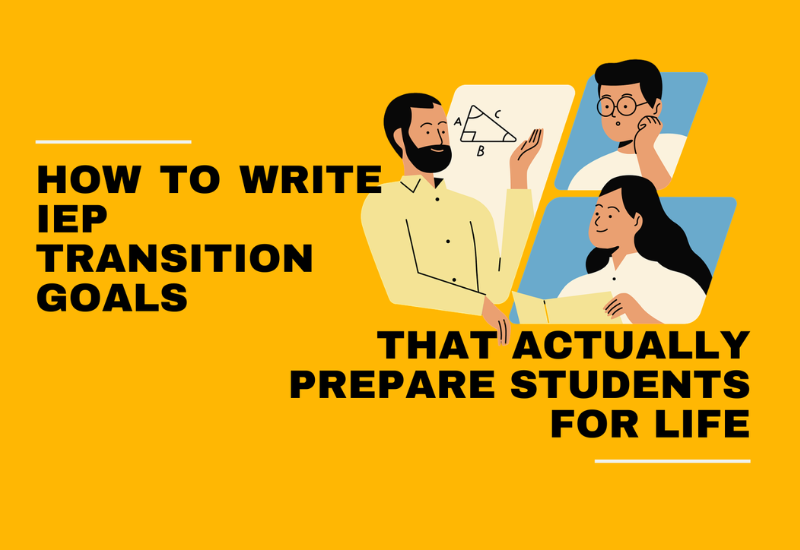As special education teachers, we carry one of the most profound responsibilities in education: preparing our students not just for graduation, but for meaningful, independent adult lives. Yet the statistics are sobering - students with disabilities face unemployment rates twice as high as their peers without disabilities.
The difference between those who struggle and those who thrive often comes down to one critical factor: comprehensive transition planning embedded throughout their special education journey.
Students who receive intentional, multi-faceted transition planning achieve dramatically better outcomes in postsecondary education, competitive employment, and independent living. But here's what many IEP teams miss: effective transition planning goes far beyond checking compliance boxes - it requires a strategic focus on seven essential skill areas that form the foundation of adult success.
1. Self-Advocacy: The Foundation of Independence
Self-advocacy isn't just a nice-to-have skill - it's the cornerstone that determines whether all other transition planning efforts will succeed or fail. When students leave the structured support system of special education, they must be able to articulate their needs, understand their rights, and confidently request accommodations.
A student who thrived with extensive IEP accommodations in high school can suddenly find themselves struggling in college or employment settings if they haven’t built the self-advocacy skills to express their goals, identify their strengths, and communicate their needs. These students are no longer passive recipients of services and need to be able to advocate for themselves.
Action Step: Begin incorporating self-advocacy instruction into IEP goals as early as middle school, progressing from teacher-supported to student-led advocacy.
2. Career Discovery: Moving Beyond "Any Job Will Do"
Traditional special education transition planning often defaults to whatever employment opportunities are readily available rather than extensively exploring careers that align with student strengths and interests. This approach limits potential and perpetuates underemployment.
When students engage in comprehensive career discovery - including interest inventories, skills assessments, informational interviews, and job shadowing - they shift from a scarcity mindset ("I'll take whatever I can get") to an empowered approach ("I'm building toward something meaningful").
Action Step: Embed career discovery activities directly into academic instruction early in the student’s middle or high school journey, connecting classroom learning to real-world applications and career pathways.
3. Employment Readiness: Bridging the Soft Skills Gap
Technical skills get students in the door, but soft skills determine whether they stay and advance. Yet many special education programs focus heavily on academic skills while under-addressing the workplace behaviors employers value most: punctuality, communication, problem-solving, and teamwork.
Employers consistently report that they can teach job-specific tasks but struggle with employees who lack fundamental workplace readiness skills. For students with disabilities, explicit instruction in these areas often determines whether they're hired or overlooked. A student who masters job applications, interview skills, and workplace reliability is positioned for long-term career growth rather than cycling through entry-level positions.
Action Step: Integrate employment readiness training throughout the school day rather than treating it as a separate unit. Practice workplace communication during group projects, embed time management skills into daily routines, and create authentic opportunities for students to demonstrate reliability and initiative.
4. Financial Literacy: The Gateway to True Independence
Financial independence represents one of the greatest challenges facing young adults with disabilities. Too many students graduate from special education programs without understanding basic money management, banking, credit, or budgeting - skills essential for independent living.
Students who lack financial literacy often find themselves in cycles of dependence, unable to manage even entry-level wages effectively or vulnerable to financial exploitation. Students who practice financial literacy before leaving high school demonstrate significantly higher rates of independent living success post-graduation.
Action Step: Embed financial literacy across academic subjects - use real-world math problems involving budgeting, incorporate consumer awareness into reading comprehension, and create authentic experiences like managing classroom economies or planning field trip budgets.
5. Individualized Transition Plan Development: Beyond Compliance
The transition component of a student's IEP should be far more than a compliance document - it should serve as a personalized roadmap connecting current learning to future aspirations. Yet too many transition plans rely on generic goals rather than reflecting each student's unique strengths, interests, and post-school vision.
Action Step: The most effective IEP transition planning involves students as active participants, families as essential partners, and teams that think beyond traditional pathways to consider all post-school possibilities. Work with the student to explore their strengths and interests and use those insights to create measurable goals tied to specific post-school outcomes.
6. Work-Based Learning: The Power of Real-World Experience
No amount of classroom instruction can replace authentic work experience. Work-based learning is one of the strongest predictors of employment success. A student who discovers they excel with numbers during an internship might pursue bookkeeping certification, for example, instead of settling for minimum wage retail. Internships, job shadowing, and work-based learning opportunities provide students with specific insights into workplace expectations while building confidence and professional networks.
Implementation Considerations: Successful work-based learning requires careful preparation, ongoing support, and intentional partnership to maximize learning outcomes.
7. Entrepreneurship: Creating Opportunities, Not Just Finding Them
While not every student will become an entrepreneur, entrepreneurial thinking - creativity, problem-solving, adaptability, and resourcefulness - benefits all students with disabilities as they navigate an increasingly dynamic work environment. Even students who ultimately choose traditional employment benefit from entrepreneurial skill development, as these competencies translate directly to workplace adaptability and leadership.
Action Step: Integrate entrepreneurial thinking into existing curriculum through project-based learning, student-run enterprises, and opportunities for creative problem-solving.
Strengthening Your Transition Planning Approach
When special education programs intentionally address these seven areas within their IEP transition planning process, students with disabilities graduate with measurably better outcomes. However, most programs excel in only two or three areas, creating hidden gaps that can significantly impact student success.
Continuous Improvement Mindset: The most effective special education programs regularly assess their transition planning strengths and areas for growth, using data to drive programmatic improvements.
Your Next Step: Speak with our team to see how University Startups can help your program strengthen each of these areas and improve outcomes for the students you serve.
Remember: transition planning isn't just a legal requirement - it's our opportunity to change trajectories and transform futures. Every student with a disability deserves not just a diploma, but a pathway to the life they envision for themselves.


.png)


.png)


.svg)



